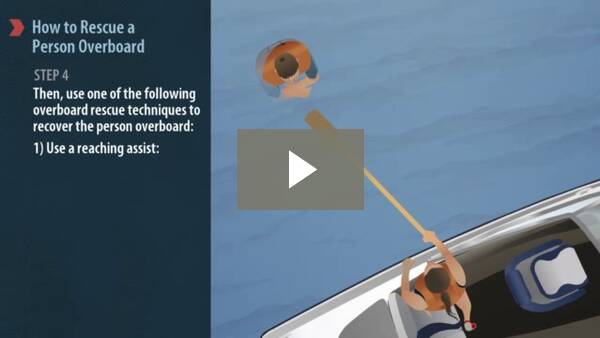Capsizing and Person Overboard Emergencies
Capsizing is the frightening experience of your boat flipping upside down in the water and it’s consistently the leading cause of all the boating-related fatalities that occur each year in the U.S.
The best way to avoid a capsizing situation is to never load your boat beyond the capacity recommendations. It can be difficult to limit the weight load—especially if more people showed up at the cabin than you had expected. However, you should never overload your boat. A heavy or unbalanced load will cause the boat to sit lower in the water, increasing the risk of being swamped by a wake. This is incredibly important if the conditions are rough—a heavy, lower-sitting boat operating in large waves makes for a dangerous situation.
Person overboard emergencies are incredibly dangerous as well. The best way to avoid a person overboard emergency is to make sure your passengers are seated at all times. Standing up in a boat, even when it’s not underway, will heighten the risk of a passenger losing their balance and falling overboard.
Loading Passengers and Equipment
Step 1) Consult the boat’s capacity recommendations and ensure that:
- Equipment and people do not exceed the recommended gross load capacity.
- The number of people do not exceed the equivalent number of adult people the boat is capable of safely carrying.
Step 2) Make sure your passengers are all wearing Coast Guard-approved life jackets.
Step 3) As the operator, you should board first and then assist each passenger aboard.
Step 4) Position equipment and passengers so that the weight is equally distributed and as low as possible throughout the boat.
Step 5) Make sure each passenger is properly seated before the next one boards.
Step 6) Securely fasten and store any equipment to prevent weight from shifting once the boat is underway. Stow gear in lockers that are easily accessible and as low as possible in the boat to help stabilize it.
Responding to a Capsizing Emergency
Step 1) Make sure every passenger is wearing a life jacket and distribute your boat’s improvised flotation devices (such as the buoyant seat cushions and life rings).
Step 2) Visually and/or verbally confirm that all of your passengers are present and accounted for.
Step 3) Determine if there are other boats nearby that can offer assistance.
Step 4) Establish if there is any danger of being hit by other boat traffic. Then determine your best course of action based on your situation:
- If you and your passengers are far from shore (50 m or more) or unable to reach shore, you should stay with the boat.
- If the boat is not fully submerged, climb onto the overturned hull. This will save your energy, increase your survival time in cold water and it will increase your visibility.
- If the capsized boat has been righted, only re-board it if it’s still afloat, seaworthy and it’s safe to do so.
- If it’s appropriate to leave the boat, you should swim to shore and seek assistance immediately.
Step 5) If necessary, use a distress signal to communicate your need for help.
Rescuing a Person Overboard
Step 1) Immediately throw the person a bright, buoyant item such as a life ring or life jacket. This will keep them afloat, increase their visibility in the water and mark their position if they submerge.
Step 2) Assign another passenger to watch the person in the water and to continuously point to their location in the water.
Step 3) Carefully angle the boat into rescue position—turn the bow into the wind and in a downwind position from the victim. This way, the person will drift toward your boat.
Step 4) Once you’re in rescue position, shut down the engine to avoid accidental movement and injury (such as a propeller strike).
Then, use one of the following overboard rescue techniques to recover the person overboard:
Use a reaching assist:
- Move to the side of the boat and keep your weight low.
- Use the reaching assist to pull the victim to the side of the boat and then assist them back into the boat.
Use a buoyant heaving line:
- Throw the buoyant heaving line so that it lands behind the victim.
- Slowly pull the line toward you so the victim can grab onto it.
- Pull the victim to the side of the boat and then assist them back into the boat.
Use a life ring:
- Make sure the life ring is secured to the boat with a line.
- Throw the life ring so that it lands behind the victim.
- Slowly pull the line toward you so the victim can grab onto it.
- Pull the victim to the side of the boat and assist them back into the boat.
Safe Boating Tip:
Never jump into the water to rescue a person who has fallen overboard. If they’re panicking and thrashing around in the water, they could pull you under.






